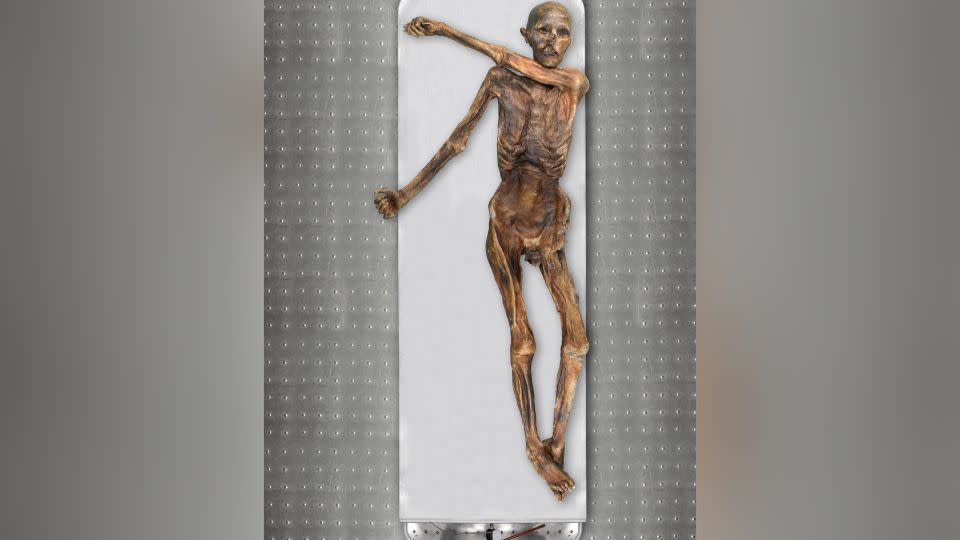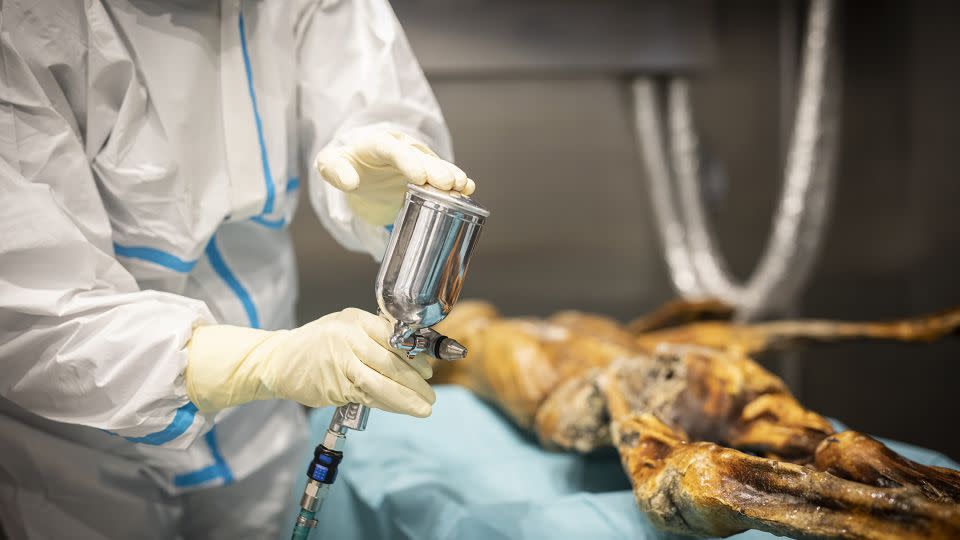Ötzi the Iceman’s true appearance revealed by new DNA analysis
- Oops!Something went wrong.Please try again later.
Editor’s note: Sign up for CNN’s Wonder Theory science newsletter. Explore the universe with news on fascinating discoveries, scientific advancements and more.
Ötzi the Iceman, whose frozen remains were found in a gully high in the Tyrolean Alps by hikers in 1991, is perhaps the world’s most closely studied corpse.
The mystery over his violent death, who he was and how he ended up on a mountain pass has sparked fascination far beyond the field of archaeology. Each year, thousands visit his mummified remains contained in a special cold cell at the South Tyrol Museum of Archaeology in Bolzano, Italy.
A new study of ancient DNA extracted from Ötzi’s pelvis suggests he still has some secrets to give up. The analysis of his genetic makeup has revealed the 5,300-year-old mummy had dark skin and dark eyes — and was likely bald. This stands in contrast to the reconstruction of Ötzi that depicts a pale-skinned man with a full head of hair and a beard.
“It was previously believed that his skin has darkened during the mummification process,” said Albert Zink, head of the Institute for Mummy Studies at Eurac Research, a private research center based in Bolzano.
“It seems that the dark skin color of the mummy is quite close to the Iceman’s skin color during (his) lifetime,” said Zink, who is a coauthor of the research published Wednesday in the scientific journal Cell Genomics.
It’s not that surprising that Ötzi was dark skinned, said Zink via email, noting that many Europeans at that time likely had darker skin pigmentation than many present-day Europeans.
“Early European farmers still had a quite dark skin, that changed with time to a lighter skin, as an adaption to the changes in climate and diet of the farmers. Farmers consume much less vitamin D in their diet compared to hunter-gatherers,” he explained.
“It seems that the Iceman still consumed quite a lot of meat, that was also confirmed by our analysis of his stomach showing the presence of ibex and deer meat,” he added.

Zink’s coauthor Johannes Krause, director of the department of archaeogenetics at the Max Planck Institute for Evolutionary Anthropology in Leipzig, Germany, said the findings suggested that the Iceman in life looked a lot more like the mummy itself.
“It is remarkable how the reconstruction is biased by our own preconception of a Stone Age human from Europe,” Krause said in a statement.
While the ancient DNA analysis suggested that Ötzi had male pattern baldness, it’s not possible to be sure to what extent he already lost hair in his lifetime, said archaeologist Lars Holger Pilø, a codirector of the Secrets of the Ice project in Norway. He has studied Ötzi but was not involved in the latest research.
“Ötzi may well have been balding for genetic reasons, but the near complete baldness he has now is in my opinion more likely due to have happened after his death,” Pilø said.
“The hairs on skin will often fall out during the (body’s) stay in and outside the ice (and sometimes in water) as the epidermis decomposes.”
Detailed genome yields more accurate info
The genome sequenced from DNA taken from Ötzi’s pelvis was more complete than a previous genome that was pieced together in 2012 when the field of ancient DNA was still in its infancy, according to the study. The latest research also helps clear up a conundrum in Ötzi’s ancestry, Pilø said.
“The application of new methods makes Ötzi a scientific gift that just keeps on giving,” Pilø added.
The 2012 study revealed that he had traces in his genome from the steppe people, sometimes known as Yamnaya, who only arrived in Europe centuries after his death. The new study shows that this early result was probably due to contamination by modern human DNA.
“The advancement in sequencing technologies allowed us to generate a high coverage genome of the Iceman. This allowed us to obtain more accurate results,” Zink said.

The genome also appeared to rule out a previously proposed genetic affinity between Ötzi and present-day Sardinians.
When the researchers of the new study compared Ötzi’s genome with those of other ancient humans, they found he had more in common with early Anatolian farmers — from what is now Turkey — who did not have much interaction with his European hunter-gatherer contemporaries.
“It does not completely change our knowledge about the Iceman but makes some things clearer,” Zink explained. “It shows that the Iceman most likely lived in a relatively isolated area with only limited contact to other populations and low gene flow from hunter-gatherer-ancestry-related populations.”
Nearly every part of Ötzi and his belongings have been analyzed, painting an intimate picture of life 5,300 years ago.
Stomach contents yielded information on his last meal and where he came from, his weapons revealed he was right-handed, and his clothes gave a rare look at what ancient actually people wore. Zink said the team hopes to uncover further details such as the composition of his microbiome.

It’s not the first time a chapter in Ötzi’s fascinating story has gotten a rewrite, Pilø said.
Originally, it was thought that Ötzi froze to death, but a 2001 X-ray revealed an arrowhead in his shoulder, which would have been fatal. He also had a head injury, possibly sustained at the same time, and his right hand shows a defense wound.
“The whole story of the Iceman is intriguing, including the mystery of his violent death … and the question why he was up there in the high mountains when he was killed,” Zink said.
For more CNN news and newsletters create an account at CNN.com

